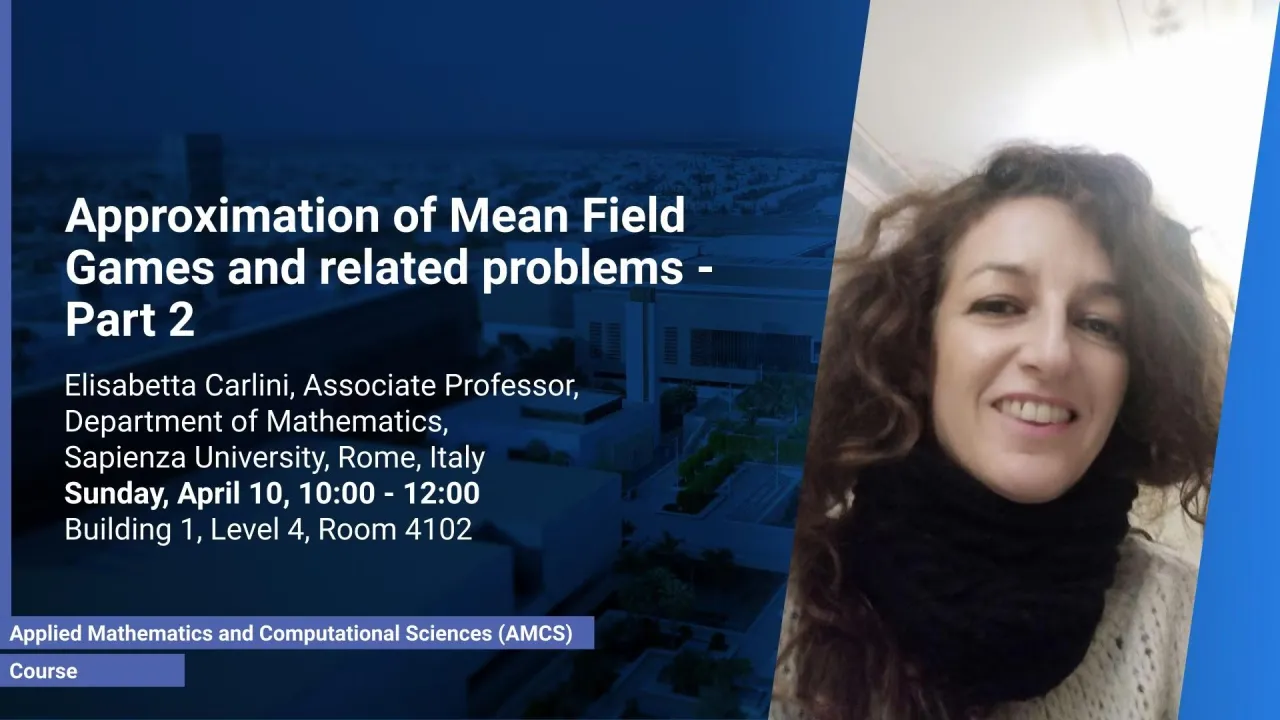
Approximation of Mean Field Games and related problems - Prof. Elisabetta Carlini -Part 2
- Prof. Elisabetta Carlini, Department of Mathematics, University Of Sapienza, Italy
B1 L4 R4102
The aim of this course is to introduce some numerical methods to solve mean field games and related problems.
Overview
Abstract
The aim of this course is to introduce some numerical methods to solve mean field games and related problems. Mean Field Games (MFGs) systems were introduced independently by [4] and [5] in order to model dynamic games with a large number of indistinguishable small players. In the model proposed in [5], the asymptotic equilibrium is described by means of a system of two Partial Diferential Equations (PDEs). The first equation, together with a final condition, is a Hamilton-Jacobi-Bellman (HJB) equation describing the value function of a representative player whose cost function depends on the distribution m of the entire population. The second equation is a Fokker-Planck (FP) equation which, together with an initial distribution m0, describes the fact that m evolves following the optimal dynamics of the typical player. We present a numerical approximation of the system based on Semi-Lagrangian (SL) and Lagrange-Galerkin (LG) schemes [2, 1, 3]. The main advantage of these approaches is to obtain explicit and conservative schemes, which allows for large time steps even when the second order terms in the MFG system are degenerated. The course is divided into two parts. In the first part we will recall some basic facts on first order HJB and Fokker-Planck equations. We will establish the well-posedness of the so-called first order MFG system, which corresponds to the case when the underlying diferential games are deterministic. We present then the standard SL scheme to solve HJB equations as well as the method introduced in [1] to solve the first order Fokker-Planck (or continuity) equation. By coupling these two methods, we obtain a full discretization of the first order MFG system for which we discuss the convergence of its solution to the solution of the MFG system. In the second part we will consider second-order MFGs systems.
We will recall some results about the existence and uniqueness of solutions. We will construct the SL method for second order parabolic equations and for a HJB equation. We will introduce a LG-type approximation for the nonlinear FP equation and for the complete MFG system. For all methods some convergence results will be analyzed.We will conclude with some applications: a MFG system with two populations, a Hughes type model, and a MFG problem on networks.
Brief Biography
- 1993-2000 Degree in Mathematics, “Università degli Studi Roma Tre”.
- 2000-2003 Ph.D in Mathematics, Numerical Analysis, Department “Metodi e Modelli Matematici per lescienze applicate”, Sapienza University, Rome, Italy
- 2004-2005 Post-Doc Fellowship in the group ‘EDP et Matériaux’, Centre d’Enseignement et de Rechercheen Mathématiques, Informatique et Calcul Scientifique, Ecole Nationale des Ponts et Chaussées, Marnela Vallé, France.
- 2005-2007 Post-Doc Fellowship, Istituto Nazionale di Alta Matematica Franceso Severi INdAM, Sapienza University, Rome, Italy
- 2007-2008 Research Fellowship, Department of Mathematics, Sapienza University, Rome, Italy
- 2008-2018 Assistant professor at the Department of Mathematics, Sapienza University, Rome, Italy
- 2018-now Associate professor at the Department of Mathematics, Sapienza University, Rome, Italy